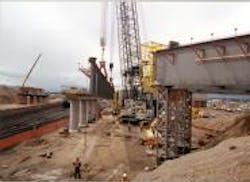“Our nation’s highway system benefits all Americans, even those who are not drivers. However, in recent years, user revenues are paying for a smaller share of the pie. That means the broader population is paying a bigger share.” –Marcus Peacock, director of Subsidyscope, a project under the aegis of the Pew Economic Policy Group
Here’s a thorny issue to consider in the ongoing debate over how to pay for transportation infrastructure: the increasing role of “non-user” monies to fund highway maintenance and construction needs.
In a detailed analysis of highway funding sources conducted by the Subsidyscope project – an initiative of the Pew Charitable Trusts’ economic policy group – highways are increasingly paid for by "non-user" fees, including sales, income and property taxes. The report shows that in recent years, these revenues are funding a greater share of highway construction and maintenance projects, with a corresponding decrease in the percentage of user contributions – including gas taxes, vehicle registrations and tolls.
[I’d like to note here that, despite the high-wattage brain power employed by Pew, they keep referring to HTF funding in this study as being derived from “gas taxes.” Um, folks, ever hear of something called “diesel” perchance? Now, I was only a lowly history major in college, but even I figured out there’s more than one form of petroleum-based vehicle fuel being taxed by the states and the federal government. So I’m changing “gas tax” to “fuel tax” in my post here.]
Pew’s researchers noted that highways – which span over four million miles in the U.S. – are supposed to rely implicitly on the Highway Trust Fund (HTF) as the primary means for financing highways; funding almost wholly obtained from fuel tax receipts. Yet the portion of costs covered by the HTF has declined steadily over the last four decades, meaning government is dipping more frequently into other revenue sources to pay for highway needs.
Various factors account for the shift in funding away from users fees, Subsidyscope found, including the fact that fuels taxes, which are not indexed to increase with inflation, are losing their buying power. [You can see that decline charted below. The orange line on the top -- user fees -- is declining, while non-user fees -- the blue line -- are rising.]
As new technologies develop, cars [and trucks, too – gee, you guys DO realize truckers pay fuel taxes, right?] are becoming more fuel efficient, requiring less fuel, and contributing fewer dollars in user fees. At the same time, costs are increasing for both maintenance and new road construction, so there’s a growing disparity between the amount of money raised in taxes and what’s being spent on highways.
The result of that disparity is, of course, predictable – today, Pew found, user fee revenue as a share of total highway-related funds is at an all-time low since the Interstate Highway System was created in 1957
Using Federal Highway Administration statistics, Subsidyscope determined that in 2007, 51% of the nation's $193 billion set aside for highway construction and maintenance was generated through user fees—down from just a decade ago, when user fees made up 61% of total spending on roads. Going back further, the trend is more pronounced. Forty years ago, user fees amounted to 71% of revenues spent on roads.
As a result, in 2007, non-user revenues contributed $70 billion to the highway system. By comparison, this contribution totaled $26 billion in 1967 (in 2007 dollars).
Subsidyscope also addressed another tricky issue when it comes to highway funding: the fact that not all user fees collected are made available for highway purposes. Of the 18.4 cent per gallon federal tax on gasoline, for example, 2.86 cents are allocated specifically for mass transit projects. Another 0.1 cent per gallon is used to pay for environmental cleanup resulting from leaking fuel storage tanks. Also, from 1990 to 1997, the federal government also set aside a portion of taxes on gasoline, diesel and other fuels to reduce budget deficits.
However, according to Subsidyscope calculations, even if those funds were fully devoted to highways, total user fee revenue would only have accounted for only 65% of all funds set aside for highways in 2007 – down from 84% in 1997 and 77% in 1967.
Also, noted Pew’s researchers, the amount of federal gas tax allocated to highway purposes has not increased since 1997 and states have had trouble increasing fuel taxes to keep up with inflation. So, in addition to a decline in user fee revenue, federal dollars are declining as a share of total highway funding – meaning state and local governments are taking on a higher share of road costs, and thus are increasingly reliant on alternative sources of revenue.
One of these sources – aside from income and property taxes – is borrowing through bond measures, which made up almost 13% of highway funds available in 2007, Subsidyscope found. This number has fluctuated over the years. Moreover, the use of bonds to fund roads varies widely from state to state. Subsidyscope considers bonds separately from user fees and other revenue because it is not clear which sources of revenues will be used to repay the bonds.
What does all this mean for trucking? Well, I think you can bet your bottom dollar that this report is going to buttress calls for higher fuel taxes – something many groups, truckers included, already support. Yet the real issue won’t be raising fuel taxes – it’ll be making sure said taxes don’t get siphoned off to fund other stuff, the way other sources of funding are now being tapped for highways.
